The Samsung Galaxy Note 4 Review
by Joshua Ho on October 15, 2014 9:00 AM EST- Posted in
- Smartphones
- Samsung
- Android
- Mobile
- Galaxy Note 4
Battery Life
Battery life is one of the most important aspects of any mobile device, especially because the battery is what defines mobility to begin with. As a result, it’s important to test battery life in a meaningful manner. This requires a repeatable test with standardized conditions, and a range of scenarios that stress different aspects to get the full picture. Most importantly, for tests that have the display on we calibrate the display to 200 nits to ensure that the test doesn’t penalize brighter displays. In the case of the Galaxy Note 4, we see about a 3% gain in battery capacity, so most of the battery life gains should come from higher efficiency.
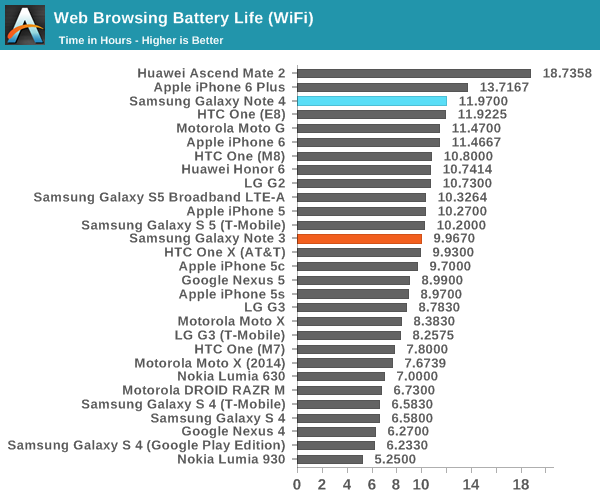
Our first test is the WiFi web browsing test, which loads a given set of web pages in a loop, with special emphasis taken in order to ensure that the test doesn’t penalize faster SoCs, which would have significant effects on our results. As one can see above, the Galaxy Note 4 has a noticeable uplift in battery life when compared to the Galaxy S5 and lasts significantly longer than the Galaxy Note 3. It doesn’t last quite as long as the iPhone 6 Plus, but few people should have issues getting through a full day of intensive use.
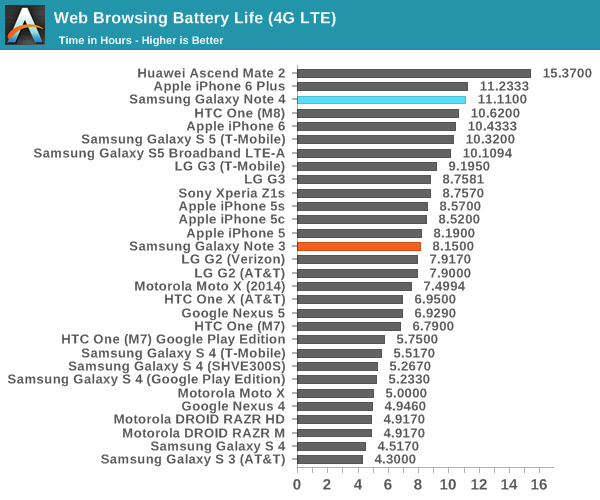
On LTE web browsing, a similar story plays out as the Galaxy Note 4 is able to keep up with the competition and delivers the massive improvement that we’ve generally seen from the transition to Snapdragon 801 and 805.
While the web tests are well-worn by now, we’ve added two additional tests to the battery life suite in order to get a better picture of SoC-bound battery life. To this end, we use an infinite loop of T-Rex on-screen to replicate a GPU-intensive scenario and Basemark OS II’s battery life test to simulate a CPU-intensive scenario.
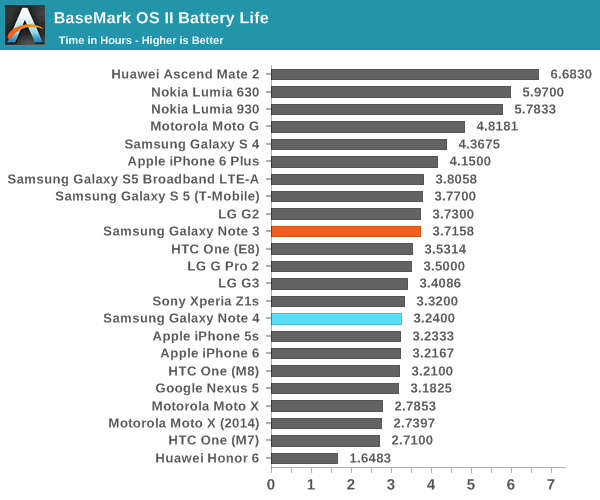
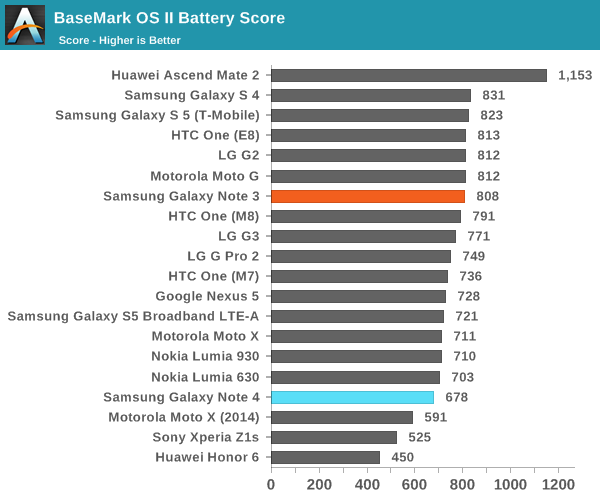
In the case of the Basemark OS II test, we see that battery life under a sustained task ends up a bit lower than we expect, which seems to suggest that in CPU-bound tasks the Note 4 doesn't have much better efficiency when compared to the Galaxy Note 3. This seems to be self-evident, as the CPUs are quite similar and the process technology used is largely similar when comparing the two devices.
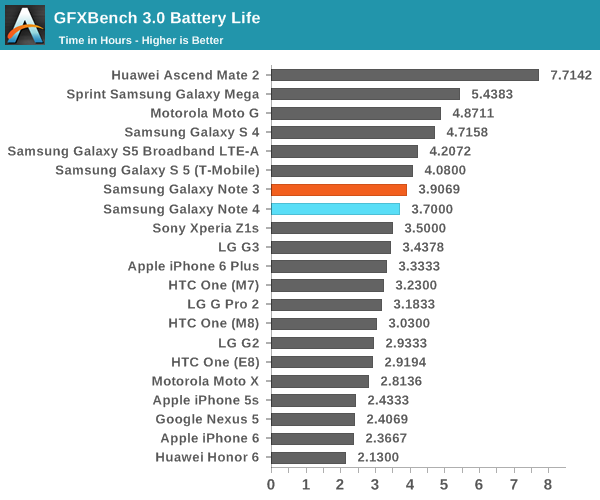
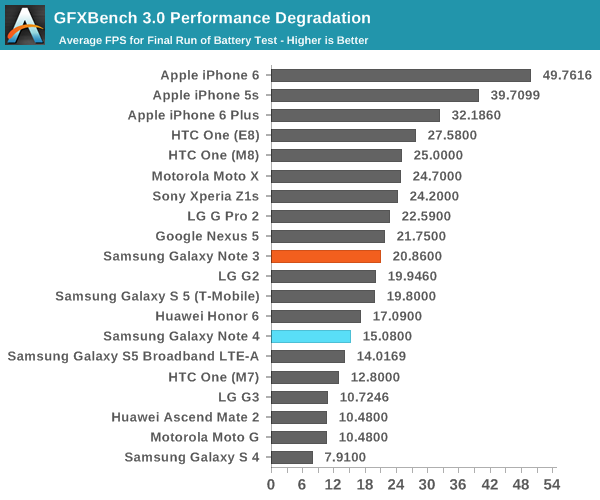
In GFXBench's endless rundown test we see that the Galaxy Note 4 trails behind in battery life when compared to the GS5 LTE-A, but looking at the end of run FPS it’s quite clear that the Galaxy Note 4’s larger surface area makes it possible to achieve greater performance.
Overall, battery life is quite good on the Galaxy Note 4. It’s a massive leap forward when compared to the Galaxy Note 3, but a relatively small one when compared to the Galaxy S5. Once again, we see that most of the benefits in battery life will come from scenarios where power draw isn’t strongly influenced by the display.
Charge Time
As a part of the overall battery life story, it's important to consider the time it takes for a battery to fully charge. If a phone's battery charges slowly then scenarios where charge time becomes crucial will severely hurt real-world battery life. For example, if one forgets to charge their phone at night, the rate at which the phone will charge the battery is a strong influence upon actual battery life. In order to test this, we measure power draw from the time that the device under test is plugged in until it reaches a given level of power draw that indicates that the battery is fully charged.
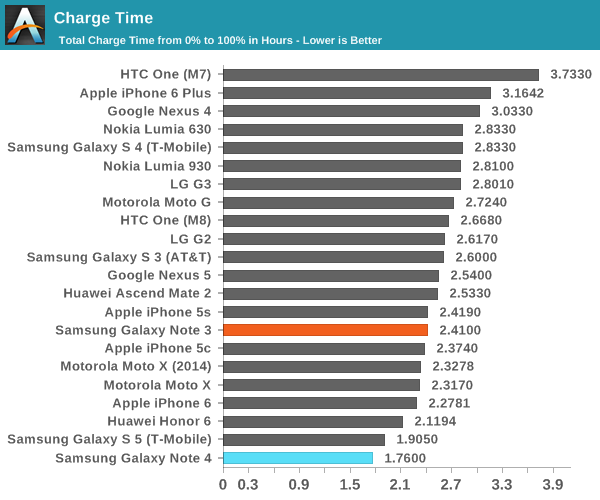
As one can see in the graph above, the adaptive fast-charge mechanism really works, although I don't see a huge benefit when compared to the Galaxy S5's charge time which was already incredibly fast. In the case of the Galaxy Note 4 it seems that it switches between a 9V, 1.64A mode and a 5V, 2A mode as needed, and most of the benefit would come from the first 50% or so of charging as power drops rapidly as the battery approaches full charge.










195 Comments
View All Comments
theduckofdeath - Wednesday, October 15, 2014 - link
I think this is a US centric site and the Exynos variant will probably never be on sale in the US.gunsman - Wednesday, October 15, 2014 - link
Will you guys be getting the international version of this as well? Would love to see performance of A57/A53 compared to the 805. Would also love to see comparison of ARMv7 A57/A53 to (when it comes out) ARMv8 enabled A57/A53 to see benefits of new instruction sets and 64 bitmayankleoboy1 - Wednesday, October 15, 2014 - link
thisMost important think about the Note4 is the Exynos 5433 SOC, which is on the 20nm node. Snapdragon 805 is a known entity.
mpokwsths - Wednesday, October 15, 2014 - link
@JoshHo: You do know that the NAND performance measurements and comparisons between different OS and benchmark programs is not accurate, right? I own a Nexus 5 which, with Android L preview, achieves more than double the performance figures than with Kitkat. That same has been observed with other Android L devices: http://forum.xda-developers.com/nexus-7-2013/gener...I'm saying this because of the misleading graphs you provide, showing the iphones miles ahead of Kitkat android devices. Well, they are NOT. They are just on a different OS / benchmark. Iphones should be removed from the graph ASAP, or include some Android L preview measurements as well. Otherwise, the NAND performance graphs are highly misleading.
JoshHo - Wednesday, October 15, 2014 - link
I don't have any particular reason to suspect Androbench pre-Android L, but I would expect some sort of compatibility issue with Androbench and Android L dev preview.NAND performance is generally not OS-dependent.
mpokwsths - Wednesday, October 15, 2014 - link
OS AND bench programI would expect a great amount of optimizations in the fs layer / kernel i/o scheduler and caching departments, together with newer controller device drivers of Android L. To make things simple: What if the compatibility issue of Androbench is with Kitkat and only with Android L will the true performance numbers show?
We will know soon enough...
Ortanon - Wednesday, October 15, 2014 - link
LOL What are you talking about? The Galaxy Note 4 is a package of hardware and software. Your Nexus 5 has Android L Preview on it; The Galaxy Note 4 does not. It gets the benchmark rating that it gets, and the iPhone gets the rating that it gets.mpokwsths - Wednesday, October 15, 2014 - link
whatever....uhuznaa - Wednesday, October 15, 2014 - link
What's wrong with testing devices with the OS that they're actually delivered with? After all it's the performance you'll see in actual use.KPOM - Wednesday, October 15, 2014 - link
We all know that the first thing the average consumer does is root the phone and install a bootleg version of the OS.